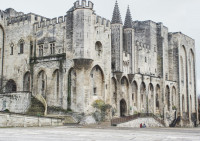Table of Contents
GOTHIC RESONANCES / RESONANCES GOTHIQUES
INTERNATIONAL SYMPOSIUM / COLLOQUE INTERNATIONAL
7-9 September 2023
Palais des Papes, Avignon Google Maps
This colloquium was held in French and English, according to speaker preference.
Link to the full program of the completed symposium
Gothic Resonances
Understanding heritage music-making spaces through the prism of archaeoacoustics (Musicology, Art History, History, Acoustics)
Call for Contributions
Please find here the call for contributions flyer (English/Français).
Scientific scope
Many musicologists have sought to demonstrate the link and interactions between acoustic space and the practice and evolution of musical repertoires. How can we not link, for example, the new construction of the choir of Notre-Dame at the end of the 12th century and the abundance of polyphonic experimentation referred to as the “Notre Dame de Paris School”? Other places, such as the Chapelle Saint-Pierre Saint-Paul in the Palais de Papes in Avignon, lead researchers to ask the same questions about a strong interaction between architecture, musical interpretation, and compositional techniques. The same is true of studies, from all periods, of holy chapels or large domed churches in the Eastern architectural tradition.
The international symposium Gothic Resonances is an opportunity to take stock of research in the fields of archaeo-acoustics in connection with musicology, history, and art history while also questioning the point of view of the performers of sacred medieval chant who experiment with the acoustics of concert venues to find favorable resonances under Gothic vaults. Collaboration between researchers in the humanities and the sound sciences has become a major issue in early music research. The very object of these questions now allows for innovative field experiments in archaeoacoustics and is linked to musicological research centered on the interaction of a production site with musical and vocal gestures. The choice of musical corpus must therefore be accompanied by research into musical iconography and archival studies to better locate the singers, their number, and age and to describe the furniture, hangings, and textiles of the clothes that had a definite influence on the resonance of the voices. This interdisciplinary research on the virtual reconstruction of heritage sound spaces has led to the creation of three-dimensional acoustic sound models using the principle of auralisation.
These new sensory experiences of architectural space open up innovative scientific perspectives between theory and practice and promote new ways of re-creating and disseminating musical heritage that deserve to be shared and discussed.
Committees
| Scientific committee | Organisation committee |
|---|---|
| Frédéric Billiet (Sorbonne Université) | Frédéric Billiet (Sorbonne Université) |
| Susan Boyton (Columbia University) | Julien Ferrando (Aix Marseille Université) |
| Béatrice Caseau (Sorbonne Université) | Béatrice Caseau (Sorbonne Université) |
| John Cooper, (Southwestern University) | Louise Condi (Sorbonne Université) |
| Mark Everist (University of Southampton) | Agnès Puissilieux (Sorbonne Université) |
| Julien Ferrando (Aix Marseille Université) | |
| Brian F.G. Katz (Sorbonne Université) | |
| Dany Sandron (Sorbonne Université) |
Sponsors
This conference is sponsored by the following research projects: EU JPI-CH PHE "The Past Has Ears", ANR PHEND "The Past Has Ears at Notre-Dame", and IMAPI « Immersion Musicale en Acoustique Patrimoniale Immersive », covering from ancient Greece, the Middle Ages, and current uses of heritage architecture.
Additional funding is provided by the Collegium Musicae, Sorbonne University and the Avignon Tourism bureau.
Contact
Please address any questions/requests related to this colloquium to resonances.gothiques@gmail.com


